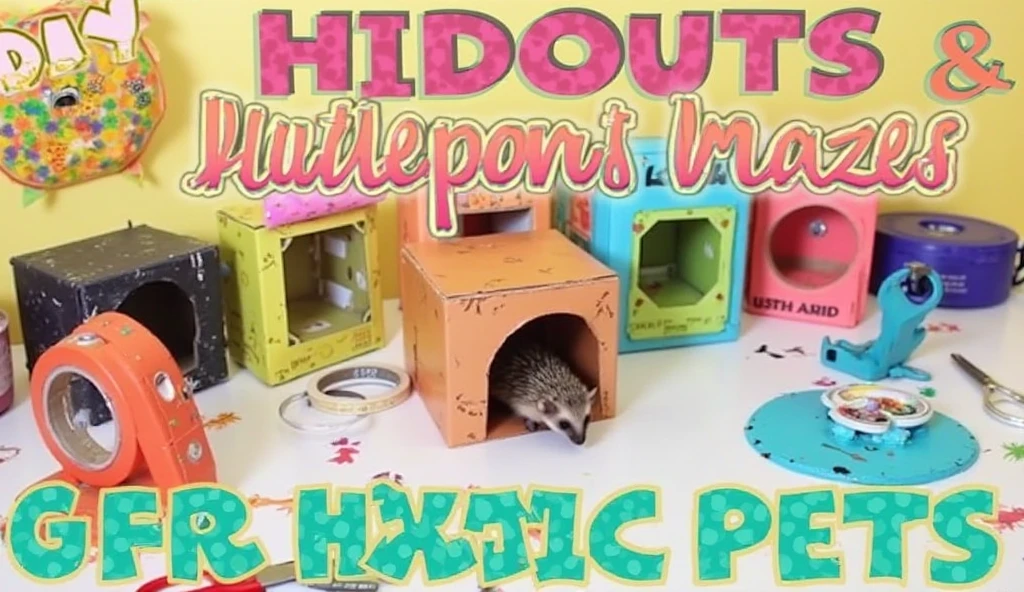Small exotic pets like hedgehogs, hamsters, sugar gliders, and reptiles love to explore and hide. Creating your own DIY hideouts and mazes at home can be fun, inexpensive, and enriching for your pet. These projects provide mental stimulation, encourage exercise, and give your pet a sense of safety.
In this guide, you’ll learn how to make simple, safe, and creative hideouts and mazes using everyday materials.

Why DIY Hideouts and Mazes Are Great for Exotic Pets
Small exotic pets are curious and love to explore. In the wild, they would spend a lot of time searching for food, climbing, hiding, or digging. In captivity, it’s your job to recreate that experience.
Benefits of DIY pet enrichment:
- Boosts physical activity
- Reduces boredom and stress
- Encourages natural behaviors
- Strengthens bond between you and your pet
- Budget-friendly alternative to store-bought toys
Safe Materials to Use for DIY Projects
Before you start building, it’s important to know what materials are safe for your pet. Here are some commonly used, pet-safe supplies:
| Material | Pet-Safe For | Notes |
|---|---|---|
| Cardboard | Hamsters, hedgehogs, reptiles | Remove any tape or ink |
| PVC Pipes | Sugar gliders, reptiles | Smooth edges to prevent injury |
| Fleece Fabric | Hedgehogs, sugar gliders | No loose threads |
| Non-toxic Wood | All small pets | Avoid treated or painted wood |
| Paper towel rolls | Hamsters, mice | Great for tunnels and chew toys |
| Plastic containers | Reptiles (with ventilation holes) | Avoid sharp edges |
Always avoid glue, staples, toxic paint, or any sharp objects when crafting for your pet.
DIY Hideout Ideas for Small Pets
Hideouts give your pet a private space to sleep or relax. You can get creative based on your pet’s size and habits.
1. Cardboard Box Hideaway
- Best for: Hamsters, hedgehogs, sugar gliders
- Use a small cardboard box and cut an entrance hole.
- Line the inside with soft fleece or bedding.
- Decorate the outside with safe paint or paper.
Pro tip: Add multiple exits for nervous pets.
2. Fleece Tunnel or Pouch
- Best for: Sugar gliders, hedgehogs
- Sew a fleece tunnel or use a sock with the end cut off.
- Make sure there are no loose threads.
- Hang it inside the cage for climbing fun.
3. Plastic Igloo or Dome
- Best for: Reptiles, small mammals
- Reuse clean food containers by cutting an arched doorway.
- Sand down any sharp edges for safety.
DIY Maze Projects for Playtime
Mazes are a great way to challenge your pet’s brain and body. You can build simple or complex structures depending on space and time.
1. Shoebox Maze
- Use multiple shoeboxes or cardboard panels to create paths.
- Cut doors into the sides and tape them together into a maze.
- Place small treats at the ends to encourage exploration.
2. PVC Pipe Maze
- Connect short PVC pipe segments to make tunnels.
- Use T-joints or elbows to create branches and curves.
- Great for reptiles, hedgehogs, and ferrets.
3. Paper Roll Puzzle
- Flatten toilet paper rolls and cut openings on the sides.
- Arrange them in a zigzag shape and stuff treats inside.
- Best for small rodents like mice or hamsters.
Tips for Making DIY Pet Mazes Safe
- Always supervise your pet during playtime.
- Clean and replace cardboard structures regularly.
- Avoid materials that could be swallowed or chewed into sharp pieces.
- Make sure all entrances are wide enough for your pet to enter and exit easily.
- Test the maze yourself with a small ball or toy before letting your pet try it.
Customizing for Your Pet’s Needs
Each exotic pet has different preferences. Here’s how to customize:
| Pet Type | Favorite Maze Features | Recommended Hideouts |
|---|---|---|
| Hamsters | Small tunnels, chewable walls | Cardboard houses, toilet rolls |
| Hedgehogs | Wide, dark tunnels | Fleece-lined boxes or pouches |
| Sugar Gliders | Vertical climbing spots, pouches | Hanging fleece hammocks |
| Reptiles | Cool, shaded hide spots | PVC domes, half logs |
Final Thoughts: Enrich Your Pet’s Life With DIY Projects
Creating DIY hideouts and mazes for your small exotic pets is a great way to keep them active and happy. You don’t need expensive materials—just creativity, basic tools, and safety in mind.
A well-designed hideout or maze encourages natural behaviors, helps reduce boredom, and strengthens your bond with your pet. Whether it’s a simple cardboard box or a full obstacle course, your pet will appreciate the effort and stimulation.
Start small, stay safe, and have fun building!

